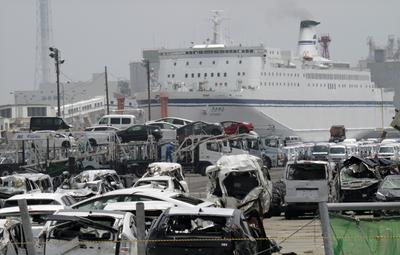Japanese automobile assemblers like Toyota and Honda, whose production requires tens of thousands of parts and components, have achieved their competitiveness by setting up and managing efficient supply chains under which parts and components are delivered by specialist suppliers just in time for their use. This has enabled assemblers to cut production costs and maintain high quality.
A low production cost was realised as assemblers do not have to hold inventories of parts and components, while the use of high quality parts is made possible by tough competition among suppliers and close cooperation on technological development between automobile assemblers and parts and components suppliers.
The earthquake and tsunami tore apart the supply chains in automobile production by destroying many parts and components suppliers. The magnitude of the damage has been immense because parts and components operations were concentrated in the Tohoku region due to its relative underdevelopment and the subsequent availability of low-wage workers. Local governments also played a role by instituting policies to attract firms.
In the wake of the disasters, many essential parts and components were simply not delivered. As a consequence, the quantity of automobile production in Japan dropped sharply following the disasters. Compared to the same time last year, automobile production has declined by 57.1 per cent in March and 60.1 per cent in April. This substantial drop in domestic production resulted in a reduction in automobile exports. The number of automobile exports declined by 25.8 per cent in March from the previous year and the rate of decline increased sharply in April to 67.9 per cent. The reduction in automobile exports, which account for a large portion of Japan’s export earnings, contributed to Japan’s trade deficit in April, the first of its kind in 31 years. The impacts spread to auto production in foreign countries, which depend on parts and components from Japan. Auto production at foreign affiliates of Japanese auto companies declined 19.2 per cent in April from the previous year.
The magnitude of the impacts was exacerbated by the fact that Japanese auto assemblers depended on parts and components suppliers whose products were not easily substitutable.
Three months have passed since the disasters, and the recovery of the supply chains has been much faster than expected. In late April, the capacity utilisation of Japanese automobile production was only around 50 per cent because of the shortage in parts and components. Capacity utilisation is expected to exceed 80 per cent in June and to reach more or less 100 per cent by August as the supply chain recovers from the serious damage. Overseas production of Japanese automakers is also expected to rise with the recovery of the parts and components supply. This quick recovery is attributable to cooperation between parts and components suppliers and auto assemblers. Auto assemblers helped parts and components suppliers by providing financial assistance for reconstruction of the damaged facilities and by sending engineers and other staff to assist with running operations. Parts and components suppliers helped each other by letting the suppliers with damaged facilities use idle machinery and equipment owned by undamaged suppliers, so that the parts and components suppliers as a group could avoid losing business.
Damaged supply chains are recovering quickly, but this does not indicate a return to the pre-disaster situation. Many assemblers are diversifying their procurement sources for parts and components to deal with the possible risk of natural disasters in the future, with parts and components suppliers following suit. Issues relating to electricity supply stemming from problems with nuclear electricity generation, continuing yen appreciation, and a delay in the scheduled reduction in the corporate income tax rate to finance reconstruction, have also forced Japanese parts and components suppliers to relocate overseas. These changes amount to a break up of the supply chains in Japan that is likely to undermine the competitiveness of Japanese production of automobiles and other machinery.
In order to stop or slow down the break up process, the Japanese government has to formulate and implement appropriate policies to improve the business environment surrounding parts and components suppliers. Specifically, the Japanese government should actively pursue policies to promote foreign trade by reviving/salvaging the WTO’s Doha Development Agenda and by expanding the network of free trade agreements so that automobile assemblers can increase exports and production. In addition, the Japanese government has to formulate an effective energy policy so that the Japanese manufacturing sector can rely on a stable supply of electricity at a reasonable cost. Finally, they must implement policies to promote innovation to improve the competitiveness of the Japanese economy including auto assemblers and parts and components suppliers.
Shujiro Urata is a professor at Waseda University’s Graduate School of Asia Pacific Studies.

